Louisville
Sanders Chair in Business, Indiana University Southeast, New Albany
Southern Indiana and the Louisville metro maintained moderate growth during 2006 and through 2007. Recent employment data, however, point to slowdowns in some sectors. Slower growth was evident in the construction, retail, and financial activities sectors and near-term growth is likely to be affected by any further contraction in the housing sector. Health care, education, and the leisure sectors showed job gains consistent with recent movements in those sectors.
Louisville Metro
The Louisville metro jumped off to a good start in 2007 and generated employment gains higher than the previous year (see Figure 1). Since the first quarter, the metro economy continues to grow in total nonfarm payrolls but at a slower rate than recent years. This slower employment growth rate is likely the result of ongoing problems in the housing sector as the housing-related sectors of construction, financial activities, and retail saw declines or slower growth in payrolls. At the time of this writing, the most recent data point to resumed minor growth in construction, continued declines in retail, and significantly lower positive growth in financial activities (see Figure 2). The Louisville metro manufacturing sector saw gains from the previous year during the first quarter, but the third quarter saw continued losses in the manufacturing sector.
Figure 1
Louisville Metro Total Employment Change by Month
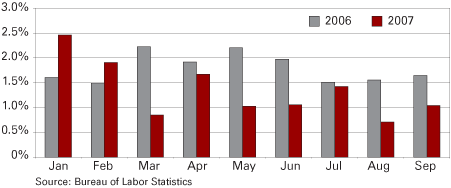
Figure 2
Louisville Metro Employment Change by Industry
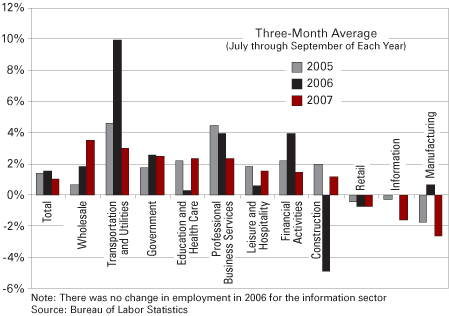
The Louisville metro also saw increases in employment in the education and health care sector, as well as in the leisure and hospitality sector. The professional and business services sector continues to increase employment, but at slower rates than in recent years. An indicator of a potential slowdown can be seen in the transportation and utilities sector. Last year, transportation and utilities generated the largest increase in payrolls, but the latest change shows a noticeable slowing.
Southern Indiana
The most recently available data at the county level also show a deceleration of southern Indiana employment gains. The Quarterly Census of Employment and Wages (QCEW), available for the first quarter of 2007, indicate that southern Indiana metro counties continued the trend of overall job growth, but these gains are noticeably lower than the previous year (see Figure 3).
Figure 3
Percent Change in Employment for the Indiana Portion of the Louisville Metro
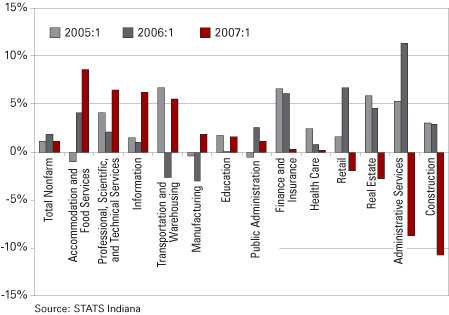
Housing sector challenges are also evident in southern Indiana metro counties. The construction sector saw declines in 2007 that almost equaled gains from the previous three years combined. Retail, the major driver of last year's job gains, actually saw declines in employment. Manufacturing showed impressive gains during the first quarter for the Indiana portion of the Louisville metro, but it is uncertain if these gains were sustained through 2007. Recent declines in manufacturing payrolls for the Louisville metro may be a preliminary signal for declines in Indiana as well.
Other housing-related sectors (finance and insurance and real estate and leasing) showed considerable declines for the first quarter of 2007. This was well in advance of this summer's credit crunch and contraction in mortgage lending, which may cause declines to continue into 2008.
Educational services saw continued increases in employment, but health care saw its smallest increase in at least the past four years. Other service-providing sectors generated significant gains compared to first quarter 2006. Professional, scientific, and technical services, transportation and warehousing, and information all produced measurable gains. A downside on the service side was a large drop in administrative services employment. Given that a large component of administrative services consists of temporary labor, this drop may be another leading indicator of a slowing economy.
Housing
Residential permits show an increase as of September 2007 (see Figure 4). An interesting development is the significant increase in multi-family permits. Continued building in the residential sector could contribute to some downside risks in housing. The additional building, combined with overall consumer credit tightening, may add to the supply of homes on the market, thus impacting overall property values. The potential of a softer labor market and higher adjustable mortgage payments in 2008 may represent the greatest threat to the local real estate market.
Figure 4
Residential Building Permits*
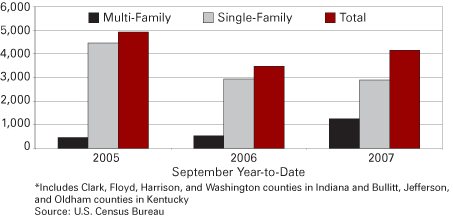
Labor Force Metrics
The southern Indiana metro counties observed higher unemployment rates during the first quarter of 2007, and rates for the second and third quarters have returned to levels similar to last year (see Figure 5). Even though third quarter unemployment rates are comparable to the third quarter of 2006, fewer people are employed in the four southern Indiana metropolitan counties. A troubling sign for the local economy's outlook is the size of the labor force and the number of people employed (see Figure 6 and Figure 7). The number employed during the third quarter is approximately 2,700 fewer than the previous year's third quarter, and the labor force shows a similar decline. These two short-run movements in the data could suggest the possibility of discouraged workers and evidence of a pending slowdown.
Figure 5
Percent Change in Monthly Unemployment Rate* from Previous Year
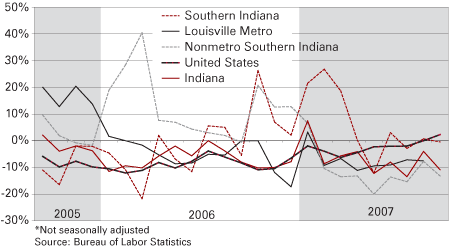
Figure 6
Percent Change in Labor Force from Previous Year
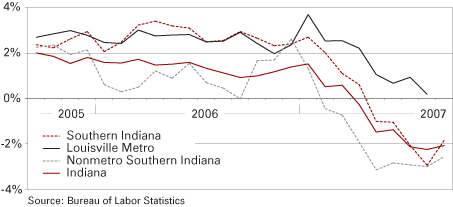
Figure 7
Percent Change in Employment from Previous Year
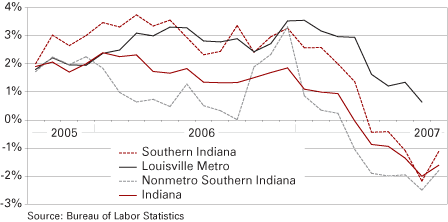
2008 Outlook
Growth in employment for 2008 will continue, but at a slower pace than in recent years. The slowdown in the housing sector will likely continue through 2008 and may place additional downside risks to local property values and the retail sector. Further declines in the value of the dollar and stronger global growth will support local manufacturing, or at least minimize the decline in employment levels. Local manufacturing growth may be counter-balanced by the possibility of a downturn in national consumer spending. A big concern is continuing developments in the housing sector and the impact on the consumer side of the economy. Energy and food prices will continue to exert pressures on consumer spending. As a result, personal income will be an important number to monitor. Overall, the outlook for the Louisville metro and southern Indiana is neutral to positive. The entire region, however, will see a lower rate of overall job growth.
Also in this Issue…
- Outlook for 2008
- The International Economy
- The U.S. Economy
- Financial Forecast
- Housing
- Indiana Agriculture
- Indiana
- Anderson
- Bloomington
- Columbus
- Evansville
- Fort Wayne
- Gary
- Indianapolis-Carmel
- Kokomo
- Louisville
- Muncie
- Richmond
- South Bend-Mishawaka and Elkhart-Goshen
- Terre Haute
- Return to Table of Contents



